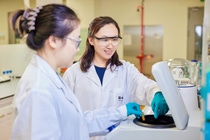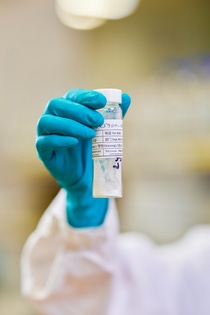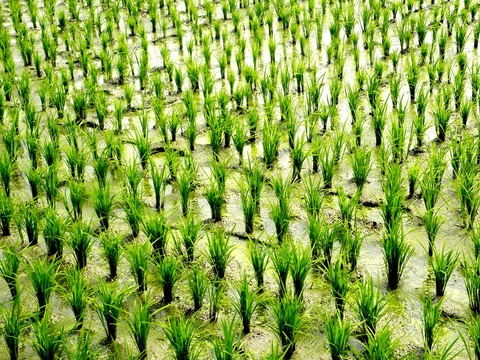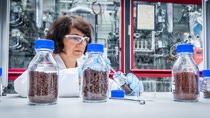Who we are
Liqun Ren
Every year, millions of tons of plastic end up in our soils and waters, where they can take hundreds of years to break down. Biopolymers offer a sustainable alternative to traditional plastics. They are made from renewable raw materials instead of crude oil or can be biodegraded by naturally occurring microbes – eliminating microplastic and reducing greenhouse gas emissions. This story follows the journey of a Chinese scientist who is developing biopolymer that could pioneer the way we produce and use polymeric materials. Liqun Ren is determined to find a solution to the plastic pollution challenge and she is confident that biopolymers can be a good option.
One could say you are working on plastics to plant. What does that mean in concrete terms?
What I do today, basically, is research the biopolymer and develop new biodegradable products for various industries, for example agriculture, cosmetics, detergents and packaging.
I study how chemicals and polymers can be broken down and metabolized by naturally occurring microbes in different environments, like soil, wastewater treatment plant sludge, and compost. With my team, we set up experiments to study the metabolization process in our lab at the Innovation Campus in Shanghai. We want to understand biodegradation in depth: what it is about, why it happens, how it happens, and how it can help us in our daily lives.

Team leader Liqun Ren is developing new biodegradable products that can be broken down by naturally ocurring microbes in the soil.
To give you one example, where our products can make a big difference: Rice is one of China's most widely grown crops. Organic farming of rice is growing in China. Traditionally, these farmers in China have to control weeds by manual power, which is very labor intensive and costly in the recent years. Second, it makes the organic farming in scale to grow very difficult. Normally, the farmers suffer the low yield and high cost from organic farming. Some farmers tried to use black polyethylene (PE) mulch films to control weeds. However, PE mulch films must be removed from the soil after harvest. This is impossible to do completely in rice field, resulting in PE film residues accumulating in the soil, as they cannot be biodegraded by soil microorganisms.
Mulch films made of certified soil-biodegradable ecovio® M2351 can solve this problem. They can be plowed into the soil after rice harvest, as naturally occurring microorganisms in the soil recognize the structure of the film as food they can metabolize. Besides weed controlling, certified soil-biodegradable mulch films can help reduce water usage and increase the organic yield to good extend. I have been working with farmers in Yunnan Province in southwestern China for several years, and it is always a joy to see how ecovio helps the organic farmers and to see the little green seedlings sprouting in the soil with no trace of our mulch film after biodegradation. This is what I mean when I say "from plastics to plant."

In the lab, Liqun Ren tests the biodegradability of research samples of new, biodegradable functional polymers.
Where is the connection between biopolymer and our everyday life?
Biopolymer are used in certified soil-biodegradable mulch films that can simply be ploughed in agricultural soil after autumn harvest and metabolized by soil fungi and bacterial to CO2 and water. That way, biopolymers help avoid polyethylene microplastics in the organic waste stream and in farmland. Another good application example for biopolymers are certified compostable organic waste bags that can be composted together with kitchen waste to produce valuable compost as soil amendment.
But the possible applications for biodegradable polymers are much more diverse. Also the detergents we use every day for laundry and dish washing contain surfactants and polymers. Biodegradable detergents, once used, are sent to the wastewater treatment plant where they get broken down by activated sludge microbes to CO2 and water. The treated water that flows back into our rivers is very pure. So biopolymers also help keep our rivers clean.

How can we prevent microplastics entering agricultural soil? Together with her team, Liqun Ren researches certified biodegradable polymers.
How can biopolymers contribute to a more sustainable world?
Biopolymers, more specifically certified biodegradable polymers, expand end-of-life options for plastic products and reduce greenhouse gas emissions compared to landfill. (Landfill will generate greenhouse gases methane and other types of toxic volatile gases, like H2S, CO). They support the circular economy by closing the nutrient cycle of the food value chain - from production via responsible consumption to organic recycling and compost for farm soil. They do so by enabling the cleaner and easier collection of organic waste and preventing microplastics from inappropriate plastic waste entering organic recycling or agricultural soil. With detergents, they help keep the treated water and thus our groundwater clean.
What are the biggest challenges in your biopolymer research?
In my everyday work, I face the exciting challenge of combining biodegradability and performance in a newly developed product. How can we design a formulation with our ecovio for certified soil-biodegradable mulch films that’s dedicated to rice in Yunnan Province? It is not easy to strike the perfect balance: we need to prevent premature biodegradation while ensuring full biodegradability after plant harvest in the soil. This is challenging because we need to ensure that the polymers can be broken down and metabolized by nature's microbes while still maintaining its functionality as a product.
What is the potential of biopolymers? Can they completely replace traditional plastic?
Biopolymers, particularly certified biodegradable polymers, are a promising material for sustainable single-use disposable products. In response to the growing “white waste” problem of packaging from online food delivery in China, we have developed paper cups and bowls coated by certified compostable polymer ecovio® PS1606. These products offer the performance qualities needed for packaging applications, while also being compostable in the organic waste treatment plants.
I do not expect that biopolymers will completely replace plastics. For example, we still need durable materials for our cars, our home appliances and other applications. However, biodegradable polymers can be a valuable alternative to traditional plastics in many packaging applications.

A research sample of a biodegradable functional polymer that Liqun Ren tested in her lab.
Why did you become a scientist?
When I was a kid, autumn was my favorite season. I loved the crisp air, the colorful leaves, and the feeling of change in the air. But I also had a lot of questions: Why do leaves fall from trees? Why do they disappear in the soil? What is their next destination? My curiosity in nature, science and technology led me to study polymer chemistry at Marburg University in Germany and my research activities today. As a scientist, I was now able to answer the questions that had fascinated me for so long.

Already as a kid, Liqun Ren was curious, how natures processes work. Now she has the answers.
What do you wish for the future?
As a mother of two, I hope that our next generations will take the responsibility continuously to build a prosperous society and a sustainable future. I am convinced that education and knowledge open up new ways for us to deal with change. Everyone can contribute to sustainability.
When Shanghai's compulsory waste sorting began in 2019, I explained to my children why it is important and we actively practiced waste sorting at home. I also tried to spend more of my free time in nature, such as hiking, and pay more attention to and protect the natural world. I believe that the best future is one in which humans and nature live in harmony, as we are interconnected in many ways.
Biodegradability
Thanks to the amazing presence of nature, with its diverse range of microbes found in the soil and compost, such as bacteria and fungi, certain chemical substances and polymers can completely break down and biodegrade. This process results in the conversion of these substances into CO2, water, biomass, and minerals, all without leaving behind any harmful microplastics in our environment.
Biopolymer
More Information
- Become a smart scientist yourself? The world needs innovation. We need you.Have a look at open positions now.


